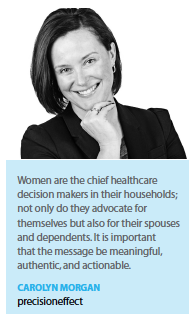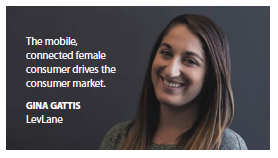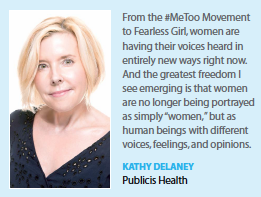Women make about 80% of healthcare decisions for their families, according to the United States Department of Labor. Crafting messaging that connects with these key decision-makers requires marketers to guard against gender-based stereotypes.
“From the #MeToo Movement to Fearless Girl, women are having their voices heard in entirely new ways right now," says Kathy Delaney, global chief commercial officer, Publicis Health. “And the greatest freedom I see emerging is that women are no longer being portrayed as simply ‘women,’ but as human beings with different voices, feelings, and opinions."
“Women are the chief healthcare decision makers in their households; not only do they advocate for themselves but also for their spouses and dependents," says Carolyn Morgan, president at precisioneffect, a healthcare advertising agency. “By understanding this target audience and where a brand fits into their life, marketers can deliver the right brand story at the right time and in the right place. It is important that the message be meaningful, authentic, and actionable."
Ms. Morgan cites for example when the agency helped MEDA relaunch PreferaOB, a prenatal vitamin, into a market cluttered with beatific pregnant women gazing adoringly at their bellies and skipping around in heels and floaty pink dresses. “I mean come on; just speak to a women in her first trimester and you get a very different picture," she says. “We did and told us just how they felt.  So we focused on the authentic things that the unique iron formulation would help solve: constipation, fatigue, and morning sickness. Our ad was Winnie Can’t Pooh. We like it because it is authentic to the end-users’ experience and clearly differentiates the brand in the market and to our target audience."
So we focused on the authentic things that the unique iron formulation would help solve: constipation, fatigue, and morning sickness. Our ad was Winnie Can’t Pooh. We like it because it is authentic to the end-users’ experience and clearly differentiates the brand in the market and to our target audience."
Gina Gattis, account manager, LevLane Life Sciences, says when marketers connect their brand with a woman, they are not just reaching an individual, they are building a relationship with a family, a community, and micro portion of your market.
“Success in reaching this powerful demographic often relies on marketing execution," she says.
Ms. Delaney agrees, noting, who wants to be portrayed as a demographic anyway? “Women and men alike are emotional creatures," she says. “We are all naturally drawn to brands that involve us, move us, and truthfully portray us with emotionally charged storytelling.
“The days of the story of the perfect wife and mother balancing family and career is pretty much over," Ms. Delaney adds. “No one feels like they get it perfectly right. Nor should they feel the pressure to. And brands that still try to push this come off as inauthentic and ridiculous. Being an imperfect mom/wife/businesswoman, a real woman with a nuanced personality, is where the world is at and that’s what should be celebrated. The ‘try’ is always there. And the honesty and realness in not being perfect is a beautiful thing."
Ms. Gattis adds that it’s important not to generalize. “Marketing to moms or single women isn’t enough," she says. “Women are a complete, multi-faceted group of people who have diverse interests and a variety of life experiences.
More than at any other time in history, women are celebrating their diversity. In turn, we recommend persona-based marketing programs to ensure marketers build strong individual relationships with their brand and allow the brand to be as diverse as the women it has to connect with."
Ms. Delaney believes that marketers can’t take a backseat to challenging negative stereotypes. “Women come from all backgrounds, economic situations, have a wide range of interests and professions," she says. “Seeing women kicking  back to watch the game or hopping out of the driver’s seat of a truck is no more unusual these days than guys folding the laundry or picking up the little ones at day school. The story of today is that there is no one story. Look around, observe the world with all its beautiful differences."
back to watch the game or hopping out of the driver’s seat of a truck is no more unusual these days than guys folding the laundry or picking up the little ones at day school. The story of today is that there is no one story. Look around, observe the world with all its beautiful differences."
Persona-based marketing efforts allow marketers to dive as deep as possible into the segmentation data and ensure that campaigns are measurable across those personas to gain insights into messaging, channels, and overall marketing success —engagement, brand conversions, sales, etc. “The persona-based marketing approach we are using to connect with female consumers has a lot of the usual demographics but filters across various life stages, for example the number of life stages that women go through from 18 to 40 and older than 40 can be quite diverse," Ms. Gattis says. “From high school to post-high school to first job to a career job, the changes and differences across those stages alone are substantial and need to be considered in all marketing efforts. Gathering data on age, ethnicity, lifestyle, family status, housing, employment, income, geography, activities, etc. provide the groundwork for not just effective persona-based marketing, but also set the standard for the brand’s analytics approach. We can see how well our message is resonating across the various sub-segments and look for success stories and areas in need of improvement. The insights gathered can help brands drive more and deeper connections with the brand and even help us build brand advocates."
Ms. Gattis says this is not about simply taking the core messages and making them “girl" friendly, she says. “Offer women a diverse variety of options, in ads, products, services, and channels," Ms. Gattis says. “It’s not just about selling, it’s about connecting to them in a meaningful way that’s organic to their lives. If your brand is just trying to sell to us just as ‘women’ it’s not going to work long-term. It’s also imperative to be authentic. Build your brand for women by women. From creative to content, marketers need to own the mindset of their audience, it’s vital in building authentic campaigns that respect women, understand women, and connect with our diversity. Don’t just talk at women, you have to speak their language if you want us to react and engage."
Ms. Delaney agrees that authenticity is important. “Now more than ever, we need authenticity to build a foundation of trust with a particular brand. “It  makes sense then that single women and moms want to be portrayed as real as possible," she says. “And if those roles involve an imperfection here and there, well, it damn well should."
makes sense then that single women and moms want to be portrayed as real as possible," she says. “And if those roles involve an imperfection here and there, well, it damn well should."
Getting Social
Ms. Gattis says because women make up the majority of healthcare social media influencers, it’s important for marketers to think mobile. “The mobile, connected female consumer drives the consumer market," she says. “Create experiences that translate to phone and allow for stronger 1:1 connections. Mobile health solutions, text messaging, and mobile-friendly content are the best way to build today’s healthcare brands for women."
She also recommends that it’s important to create social brands. Women consume and share content across all social media platforms. They make up a significant portion of healthcare bloggers. “The term ‘mommy bloggers’ didn’t happen by accident," Ms. Gatis says. “Women drive connections and your brand needs to be part of the conversation. Despite the not-so-easy-to-navigate social  media guidelines imposed on our industry, social media connections cannot be ignored. Find the micro-influencers in your category and provide these influencers with content. They are always content starved and looking for new information to share."
media guidelines imposed on our industry, social media connections cannot be ignored. Find the micro-influencers in your category and provide these influencers with content. They are always content starved and looking for new information to share."
Beyond social media, cause-marketing connects with women more than men, according to Ms. Gattis. Many women like when some portion of their spend goes to causes they believe in. This can help women feel like they’re doing more than just shopping, which can boost your brand.(PV)
~~~~~~~~~~~~~~~~~~~~~~~~~
Do’s and Don’ts of Gender Based Marketing
Do research – understand how YOUR target audience feels about what you are marketing, saying and doing. — Carolyn Morgan
Do understand the value of connecting and creating advocates who can spread their unique experiences with your brand. — Carolyn Morgan
Do understand your brand’s emotional AND intellectual appeal and leverage both at the appropriate times. — Carolyn Morgan
Do start with the why – why should they care, why should they act, why should they buy. — Carolyn Morgan
Do be a “social" brand; women consume and share content across all social media platforms. — Gina Gattis
Do be mobile. The mobile, connected female consumer drives the consumer market. — Gina Gattis
Do cause-based marketing. — Gina Gattis
Don’t oversimplify – all women are not the same. — Carolyn Morgan
Don’t underestimate their social impact. — Carolyn Morgan
Don’t think pink. — Carolyn Morgan
Don’t go straight to features and benefits. — Carolyn Morgan
Don’t generalize; take your targeting and segmentation as deep as you can. — Gina Gattis
Don’t be one-dimensional. — Gina Gattis
Don’t be un-authentic; build your brand for women by women. — Gina Gattis


















